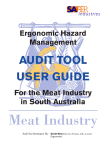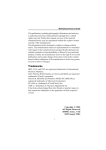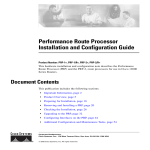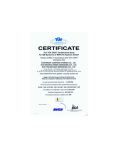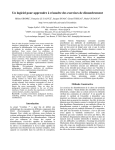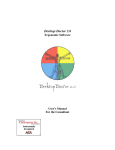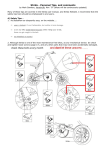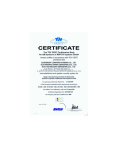Download Ergonomic Hazard Management Audit Tool User Guide for the Meat
Transcript
Ergonomic Hazard Management AUDIT TOOL USER GUIDE For the Meat Industry in South Australia Audit Tool Developed By: David Nery B.Sc Hons (Flinders), M.Sc. (London) Ergonomist Table of Contents Page About This Project 1 Acknowledgements 1 Introduction 2 Ergonomic Audits 4 How to Undertake an Ergonomic Audit At Your Site 5 Step 1: Step 2: Step 3: Step 4: Risk Identification Risk Assessment Risk Control Summary of Risk Control Options Monitor & Evaluate 5 6 7 8 12 Tips For Good Ergonomic Audits 13 Appendix A : Ergonomic Hazard Management Audit Tool - For the Meat Industry 14 Ergonomic Audit Tool User Guide About This Project This document is one of four, which have been developed by David Nery (Ergonomist, Nery Ergonomic Services) in collaboration with the SA Meat Industry OHS Committee. The full range of documents developed in this project are: • An ergonomic hazard audit tool specifically adapted for meat processing tasks • A user guide of how to use the audit tool • An industry report which provides a series of 20 case studies of ergonomic interventions in the meat industry in South Australia • A bibliography of relevant readings for ergonomics in the meat industry For more information about the documents that have been produced in this project please contact the following people or visit the SAfer Industries - Meat Industry website: www.workcover.sa.gov.au/safer Paul Sandercock, Chairperson National Meat Association Floor1/100 Greenhill Rd, Unley SA 5061 Telephone (08) 8272 2400, Facsimile (08) 8272 2433 Email: [email protected] Janice Quarrie, Executive Officer WorkCover Corporation GPO Box 2668, Adelaide SA 5001 Telephone (08) 8233 2947, Facsimile (08) 8233 2223 Email: [email protected] Acknowledgements I am grateful to the SA WorkCover Corporation Targeted Grant Scheme for funding this project and to the SA Meat Industry OHS Committee for their support throughout this project. I would also like to specifically thank the following for their profound and diligent input into this project: • The risk assessment team at George Chapman Pty Ltd • Debbie Crewe (George Chapman) • Janice Quarrie (SA Workcover Corporation) • Barry Shaw (AMIEU SA Branch) • Sue Ball (TAFE SA) I am also grateful to all the people within the industry who participated in the site visits and provided input into this project. Ergonomic Audit Tool User Guide 1 A joint project of industry and WorkCover Corporation National Meat Association • SA Food & Beverage Industry Training Council • Australasian Meat Industry Employees Union George Chapman P.L. • Tatiara Meat Company • T & R Murray Bridge P.L. • Aldinga Table Turkeys • Inghams International TAFE SA • Meat & Livestock Australia • AQIS • Workplace Services - DAIS • National Union of Workers • S.A.E.C.C.I. Introduction Injury statistics and other sources have identified manual handling and occupational overuse syndrome related injuries as some of the most frequent and severe injuries in the meat industry in South Australia. This handbook is focused on providing an audit tool to identify, assess and control these hazards in the meat industry in South Australia. This handbook is intended for use by occupational health and safety personnel and others who have the responsibility for the identification, assessment and control of manual handling related hazards within meat works. What is Manual Handling? Manual handling means “an activity requiring the use of force exerted by a person to lift, lower, push, pull, carry or otherwise move, hold or restrain any person, animal object or thing” (Code of Practice for Manual Handling, 1990, page 1). In terms of tasks in the meat industry, this translates to a whole range of activities including cutting, static muscle load in work postures, repetitive movements, pushing bins, lifting and throwing product etc.... The audit tool described in this handbook is designed specifically for the meat processing industry. Therefore, the scope of factors examined covers not only typical “manual handling” hazards but those related to Occupational Overuse Syndrome injuries. Within this handbook the term “Ergonomic Hazards” will be used to collectively describe both manual handling and occupational overuse syndrome hazards. Ergonomic Audit Tool User Guide 2 Figure 1 illustrates the interrelationship between manual handling and occupational overuse related issues in work tasks. Occupational Overuse Hazards Manual Handling Hazards Work tasks involving • Transfer of heavy loads • Non repetitive actions Work tasks involving • Repetitive or forceful movements • Maintain constrained or awkward posture Interaction of both task elements ALL MANUAL HANDLING TASKS IN MEAT PROCESSING OPERATIONS Legal Requirements for Manual Handling Assessments The Occupational Health, Safety and Welfare Regulations (1995) state that “An employer must ensure that any manual handling that is likely to be a risk to health and safety is identified and assessed… The employer must take such steps as are reasonably practicable to control the risk.” (page 89-90). This booklet and enclosed checklist are designed to meet this legal requirement by providing a practical guide for the management of manual handling hazards in the meat industry. Ergonomic Audit Tool User Guide 3 Ergonomic Audits The key to effectively managing ergonomic hazards (like many other hazards) is to analyse the hazards and their causes and then systematically control these hazards. This hazard management process consists of the following 4 main stages: 1. 2. 3. 4. Risk identification Risk assessment Risk control Monitor and evaluate This booklet summarises this process and provides some useful reference material to assist you to use the ergonomic audit document in Appendix A. Manual Handling Audit Process The key to effectively managing manual handling related hazards is to complete a risk assessment of the work tasks. The assessment of manual handling hazards is a legal requirement in the Occupational Health, Safety and Welfare Regulations (Section 2.9.3, 1995) The process that needs to be followed is summarised in Table 1. Risk Identification • Observation • Consultation • Review Injury Statistics Risk Assessment • Movement & Posture • Task & Object • Environmental Factors • Individual Factors Risk Control • Eliminate Hazard • Substitute process • Re-Engineering Controls • Administrative Controls Monitor & Evaluate Changes Table 1: An Ergonomic Hazard Management Process Ergonomic Audit Tool User Guide 4 How to Undertake An Ergonomic Audit at your Site The stages of the process are outlined in Table 1 on page 4. The form in Appendix A is the assessment tool that has been developed to complete this process. The process involves the same 4 steps described in the previous section. That is: • Step 1: Risk Identification • Step 2: Risk Assessment • Step 3: Risk Control • Step 4: Monitor & Evaluate Step 1 Risk Identification Filling out the Risk Identification Stage of the Assessment Tool The front cover of the audit tool requires information about the task, injury and claims history associated with the assessed task. This allows for some historical information about the level of risk of this task to be presented. Consultation with others involved in the task (eg. safety reps, people who have done the task ) will provide further background information. Work Example: Identification of Work Hazards. Repetitive Throwing of Product Figure 2: Boning room task. (photo courtesy of Tataria Meat Company) Ergonomic Audit Tool User Guide 5 Step 2: Risk Assessment This stage involves an assessment of the risks for the hazards that have been identified in stage 1. This requires the task assessors to nominate the level of risk for each hazard that was assessed in step 1. Assessing the level of risk is a combination of the probability the event will occur, which is affected by how often the task is undertaken (likelihood) and the extent of harm to people should the event occur (consequences). Work Example: Assessment of risk - A combination of risk severity and number of times the task is performed. That is, the more people who perform a hazardous task the greater the risk. Figure 3: A boning room operation before the room was re-designed. (photo courtesy of George Chapman) Ergonomic Audit Tool User Guide 6 Filling out the Risk Assessment Stage of the Assessment Tool Filling out the risk assessment section of the audit tool requires you to complete the following steps: • Assess the level of risk from 0 - 5 for each of the assessment items • Describe assessment of the main hazards associated with the task • Determine the overall risk rating for the task. This is the highest risk rating given to any of the factors (e.g. If all factors are rated at a level of 2 but one factor [e.g. repetition] is rated 5, the overall risk rating for the task is 5.) • One ‘yes’ answer in the personal factors section (Section E) is equivilant to an overall risk rating of 5 • Once you progress to assessing a number of tasks, you will be in a position to prioritise tasks based on how many high hazard ratings are scored per task • NB: Any aspect of any task that is rated 4 or above needs prompt or immediate attention • The key for interpreting the risk ratings in terms of the priority of action is as follows: • 0 rating = Very low priority, fix within 12 month plan • 1 rating = Low priority, fix within 3 month plan • 2 rating = Medium priority, fix within 1 month plan • 3 rating = High priority, fix within 2 week plan • 4 rating = Very high priority, fix within 1 week plan • 5 rating = Acute priority, fix by the end of the day Step 3: Risk Control Overview of the risk control stage The risk control hierarchy is the approach commonly used to develop safe methods of work. The risk control hierarchy for the management of manual handling hazards consists of the following elements: • Eliminating or minimising manual handling hazards This includes elimination, substitution and re-engineering risk control options Ergonomic Audit Tool User Guide 7 • Reducing fatigue through work reorganisation This includes the layout, management and scheduling of work options • Raising awareness and improving knowledge and skills This includes selection, training and supervision of work tasks Filling Out the Risk Control Checklist and Action Plan Stage of the Assessment Tool This audit tool provides some space on the back page for people to “tick” one or more risk control options. There is also some space for people to list the risk control options that have been selected. This information is used as the basis for the development and implementation of risk control options. Remember that elimination, substitution and re-engineering options are the best because they get rid of the hazards. While personal protective equipment (PPE) and training are vital elements of a safety system, they do not get rid of the hazard; they simply assist the individual to cope with the hazard. In some cases training and PPE are the only reasonable options available, but where possible re-engineering the hazard out of the work process is more effective. Summary of the Risk Control Options This section provides more detail about the risk control options. Examples are also provided about the how these options have been applied in meat processing scenarios. 1. Eliminating or Minimising Manual Handling Hazards This is the most effective approach as the hazard is either eliminated or minimized through engineering re-design of the process. The checklist requires a “yes” if an option is available and some space on the form to determine what the strategy might be. Examples would include: • Reviewing if the task is necessary at all? • Can another method be used? • Developing mechanical aids (eg.using conveyors rather than dump bins) Ergonomic Audit Tool User Guide 8 Example 1: Eliminating Manual Handling Hazards by Design - Head lifting Task One example of a demanding manual handling task, is lifting the animal’s head between the main chain and a head chain Figure 4: Carrying a 45 kg head between the main chain and head chain. (photo courtesy of Agpro) Figure 5: Trying to lift the head onto the head chain. (photo courtesy of Agpro) Figure 6: A head lifting machine that eliminates lifting the head. (photo courtesy of South Burnett Meat Works) Ergonomic Audit Tool User Guide 9 2. Reducing Fatigue through Work Reorganisation This will involve a review of the work organisation to reduce double handling, balance work rates/rest schedules which can if not well managed increase the risk of fatigue and injury. Example 2: Task Rotation (Between Boning & Slicing Tasks) The key to reducing physical fatigue with task rotation is to move between tasks that involve different muscle actions (e.g. Boning versus slicing). In meat processing operations it is difficult to get enormous variation in body movements because of the repetitive and similar nature of many tasks. However, some form of rotation is critical given this repetitive and non-varied nature of many tasks. Some examples of task rotation include: • Boning versus slicing tasks • Standing versus sitting tasks • High effort slaughter tasks (e.g. “punching out sheep”) versus working with air tools • High exertion muscular force (e.g. lifting pig or cattle heads) versus a task with low levels of lifting (e.g. working in the knocking box) These are just some examples of task rotation. Rotating between tasks on a more frequent basis (e.g. 2 - 4 hourly) can also provide often badly needed variation to repetitive tasks. Figure 7: Head cut up table. (photo courtesy of George Chapman) Ergonomic Audit Tool User Guide Figure 8: Slicing Task. (photo courtesy of George Chapman) 10 Figure 7 illustrates a cut up table that requires forceful repetitive upper limb movements. Figure 8 illustrates a slicing task that does also involve repetitive movements in the knife hand but the force of the slicing movements is less. This therefore, reduces the total repetitive physical exertion required by operators. 3. Raising Awareness and Improving Knowledge & Skills Interventions at this level cannot modify the task but can reduce the risk of injury by improving, where possible, the manual handling techniques of people performing the task. Example 3: Manual Handling Training In many cases people have to manual handle cartons and other products in the plant. In this case manual handling training would be required to ensure that when people manual handle they do it in the safest and most practical way. This is not only an effective risk control strategy, it is a legislative requirement. The South Australian Manual Handling Code of Practice (1990) states the following in relation to the requirement for manual handling training : “The employer must: …ensure that the employees involved in the manual handling task, receive appropriate training, (including training in safe manual handling techniques) and appropriate supervision;” (page 40) Figure 9: Manual handling cartons in the packing area. (photo courtesy of Aldinga Table Turkeys) Ergonomic Audit Tool User Guide 11 In figure 9 the operator has to use the following manual handling technique: • Hold the carton close to her body • Do not twist her spine • Keep her spine in a straight (neutral) position • Get a good grip on the carton • Plan the lift and test the load Despite using these safe manual handling techniques other risk control strategies can be used in combination with safe manual handling techniques. This would include the following: • Room layout - keep the pallet close to the scales to reduce the distance over which the carton is to be carried. Review if a conveyor could be used between the scales and the pallet to eliminate lifting • Reducing Manual Handling - Could a scissor lift be put under the pallet (a spring or hydraulic base) so the pallet was always at waist height. That is when the pallet is empty it comes to waist height and then it is lowered under weight as items are stacked on the pallet. • Task Rotation - Rotate people between this lifting task and a more static task (e.g. weighing, packing or wrapping the product). This will provide some variety in terms of movement and muscle load that will reduce fatigue for the operators. Step 4: Monitor & Evaluate This stage involves documenting time frames and responsibility for who is going to mange the implementation and evaluation of the risk control strategies that were derived in step 4. The assessment form provides a spread sheet that requires the following information: • A list of the hazards and their assessed priority • Risk control solutions • Timeframe and responsible person for implementing changes • Review date Ergonomic Audit Tool User Guide 12 Tips for Good Ergonomic Audits • Conducted by a team, not an individual. This provides a cross section of opinions about what hazards exist. • Measured against standards Using a checklist, which has been derived from a standard provides a more standard and consistent approach. This gives accurate findings and the levels of risk. • Include knowledgeable persons Use safety representatives, operators, engineers or anyone who may have an understanding of the task being assessed (you may show them your results if they cannot all attend the audit) • Be specific Where possible, quantify hazards Eg. Don’t say load is heavy. Measure its weight. Don’t say person has to reach a long way, measure it. This provides more detail about the level of risk. • Challenge customs and practice People’s response to change is sometimes “We have always done it this way,” or, “I have never hurt myself on that job, there cannot be a problem.” We need to analyse the hazards and manage these and not rely on luck as the main reason for not being injured. If not, one day your luck might run out. • When assessing level of risk consider: - the number of people exposed - how often they are exposed for - any combination of hazards - variations in the process (seasonal, different types of meat, meat from the chiller etc...). Ergonomic Audit Tool User Guide 13 Appendix A Ergonomic Audit Tool - For Meat Processing Tasks Ergonomic Audit Tool User Guide 14 ERGONOMIC HAZARD MANAGEMENT AUDIT TOOL - MEAT INDUSTRY STEP 1: RISK IDENTIFICATION CHECKLIST Company: Department: Assessor: Date: Time: INSTRUCTIONS: * Tick Boxes where applicable * Spaces allow you to write further information where required * If you identify jobs where possible risks exist use the risk assessment checklist to further examine those jobs. Task(s): Task Description: Operator Feedback - Ask people doing the task (or those who have familiarity with the task) what they think the hazards might be? What do the accident, incident or other safety records tell you about the hazards associated with this task? STEP 2: RISK ASSESSMENT A. REPETITION WHOLE BODY Idle most of the time; no regular exertions Consistent, conspicuous pauses or very slow motions 0 Slow steady exertion/motion, may have frequent pauses Steady motion/exertion; may have infrequent pauses Rapid steady motion/exertion, few if any pauses Very rapid motion/exertion, difficulty keeping up; no pauses 2 3 4 5 1 B. FORCE C. GRIP STRESS Hand/fingers Fingers No grip stress Nothing at all Greatest imaginable effort Comfortable 0 Maximum Tolerable Comfortable 1 2 3 4 5 2 3 4 5 Wrist/Palm 0 1 2 3 4 5 0 D. POSTURE Wrist Deviation Neutral Extreme Range of Motion Comfortable 1 E. PERSONAL FACTORS • New employee (under 12 months) or returning from extended leave. Yes ■ No ■ 0 1 Wrist Flex/Ext 2 3 4 5 0 Forearms 1 2 3 4 5 0 Elbows 1 2 3 4 5 0 Shoulder 1 2 3 4 5 0 1 2 3 4 5 • Inadequate skills or experience Yes ■ No ■ 0 1 2 3 4 5 • Inadequate Training Yes ■ No ■ 0 1 2 3 4 5 Neck Back • Older workers or those with recurrent disabilities Yes ■ No ■ • Restrictions imposed by personal protective equipment Yes ■ No ■ F. LOAD CHARACTERISTICS Lifting/Carrying the Load Easy to move 0 1 Greatest Imaginable effort Comfortable 2 3 4 5 2 3 4 5 Push/Pull or Restraining forces 0 1 G. WORK ENVIRONMENT / WORK ORGANISATION Workspace Does not cause a problem 0 Inconvenience Causes extra effort Hazard for safe work Will cause major injury Will cause a fatality 1 2 3 4 5 1 2 3 4 5 3 4 5 Thermal Comfort 0 Floor Surface (Wet Tripping / Slipping hazards) 0 1 2 SUMMARISING RISK ASSESSMENT RESULTS Describe assessment of the main hazards associated with task (include severity of hazard, how many people exposed to hazard). Overall Risk Assessment Rating (Highest rating on any score): (i) Training & education: Are workers training in safe manual handling? (ii) Consultation • Are people undertaking the tasks consulted about the risks associated with their work? • Are workers encouraged to suggested ideas about safer ways to work? 3. Raising Awareness and Improving Knowledge & Skills By: (i) Rescheduling tasks to allow for more consistent effort and fewer periods of high / low demand: • Is the sequence of activities efficient? • Is consideration given to balanced work / rest schedules? 2. Reducing Fatigue Through Work Recorganisation By: (i) Eliminating the task: • Is the task necessary? • Can another method be used? (ii) Mechanism or the provision of machines or aids to do the task: • Are there aids or machines which could be used? • Can the aid be made / designed? (iii) Eliminating or minimising rehandling: • Can handling be reduced by reorganising, planning, designing? 1. Eliminating or Minimising Manual Handling Hazards By: Risk Control Options Yes/ No Instructions Tick boxes where applicable • A “yes” answer for a question indicates the types of control which might be appropriate. • Control (solutions) should be developed in consultation with the people who will use them. • There are several different approaches to reducing risks of handling injuries. List the Risk Control Option (s) STEPS 3 & 4: RISK CONTROL CHECKLIST AND ACTION PLAN Fix by Responsible Review Date Person Date




















